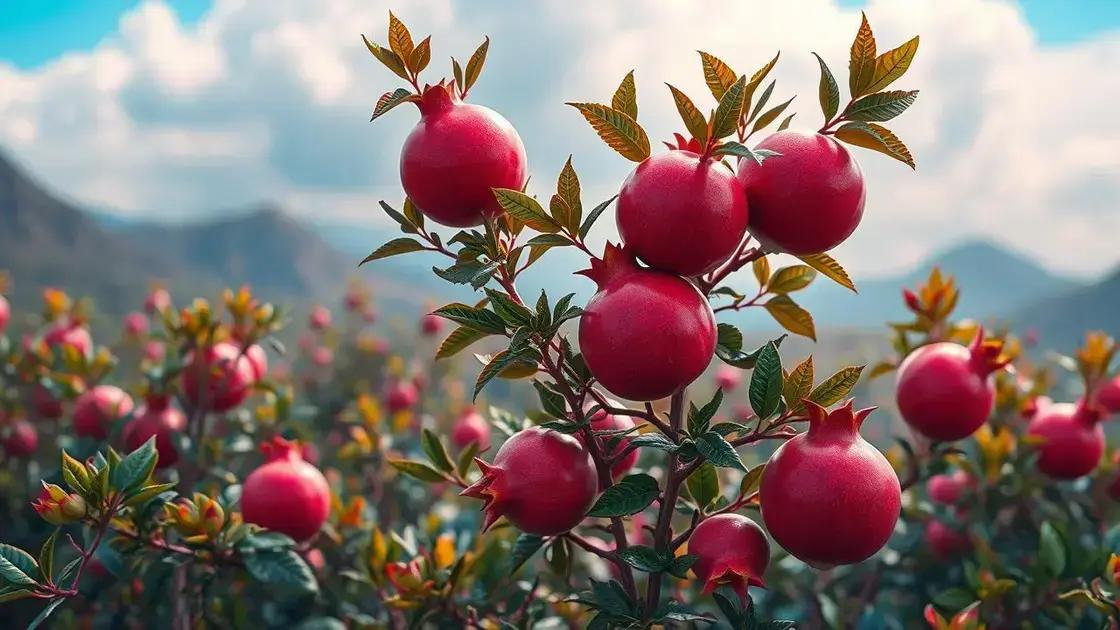How to Take Care of Pomegranate Plant: 5 Expert Tips for Success
How to take care of pomegranate plant effectively can transform your gardening experience and yield delicious fruit. Growing pomegranates in your backyard isn’t just about planting; it’s about understanding the unique needs of these vibrant plants. You’ll learn essential care techniques that every gardener should know to ensure your pomegranate thrives. Keep reading to uncover the secrets of successful pomegranate cultivation!
Table of Contents
ToggleEssential soil requirements for pomegranate success
Essential soil requirements for pomegranate success are crucial for healthy growth and productive fruiting. This Mediterranean fruit thrives best in well-draining soils with the right nutrient balance.
Understanding soil types
- Sandy soil: Ideal for drainage, sandy soil allows roots to breathe but may require more frequent watering.
- Loamy soil: A mixture of sand, silt, and clay, loamy soil retains moisture while providing excellent drainage.
- Clay soil: Heavy and dense, clay can retain water, which might lead to root rot. Adding organic matter can improve its texture.
Perfect pH levels
The pH level of the soil plays a vital role in nutrient absorption. Pomegranates prefer slightly acidic to neutral soils, typically between 5.5 to 7.0.
Soil amendments
- Organic matter: Incorporating compost or well-rotted manure enriches the soil with essential nutrients.
- Gypsum: In clay soils, gypsum helps in breaking up compacted particles, improving drainage.
- Mulch: Applying organic mulch around the base of the plant retains moisture and suppresses weeds.
Drainage techniques
Ensuring proper drainage is key to preventing waterlogging. If your soil is heavy, consider:
- Building raised beds to enhance drainage.
- Creating mounds in the planting area.
- Adding drainage tiles if planting in lower regions.
Common mistakes to avoid
- Overlooking drainage needs, which can lead to root diseases.
- Forgetting to test soil pH before planting.
- Using synthetic fertilizers excessively, which can harm soil biology.
For those interested in exploring indoor gardening techniques or growing pomegranates, understanding the soil requirements is your starting point.
Best watering techniques for thriving pomegranate plants

Best watering techniques for thriving pomegranate plants are essential for their growth and fruit production. Proper watering not only supports healthy roots but also minimizes stress during hot weather.
Understanding watering needs
Pomegranate plants require a careful balance of moisture, especially during key growth stages:
- During establishment: Keep the soil consistently moist for the first few months after planting.
- In bloom: Increase moisture to support flower development.
- During fruit development: Adequate watering helps in achieving plump, juicy fruits.
Effective watering techniques
Utilizing the right techniques can enhance water absorption while minimizing waste:
- Drip irrigation: This method allows water to drip directly onto the soil, targeting the root zone.
- Soaker hoses: Lay soaker hoses on the soil surface to provide gradual moisture over large areas.
- Deep watering: Ensure water reaches at least 12 inches deep in the soil to promote strong root systems.
Signs of over or under-watering
- Under-watering: Leaves may wilt, and fruit may be small or shriveled.
- Over-watering: Yellowing leaves and root rot can occur; soil appears soggy.
Watering frequency
The frequency of watering depends on climatic conditions, soil type, and plant age:
- Young plants: Water every 2-3 days during the growing season.
- Mature plants: Adjust frequency to weekly, increasing during hotter months.
For those interested in exploring indoor gardening techniques, understanding the watering needs of pomegranates is vital for their success.
Effective pest control methods for pomegranate care
Effective pest control methods for pomegranate care are vital in safeguarding your plants from potential threats. By employing the right techniques, you can ensure a healthy crop and prevent pest infestations.
Common pests affecting pomegranate plants
- Fruit flies: These insects can lay eggs in the fruit, causing decay.
- Scale insects: Often found on stems and leaves, they can weaken plants by sucking sap.
- Leafcutter bees: These bees may harm foliage, but they are generally beneficial for pollination.
Natural pest control techniques
Utilizing natural methods can help keep your pomegranate plants healthy:
- Diatomaceous earth: Sprinkle this powder on the soil to deter many crawling pests.
- Neem oil: A natural pesticide that disrupts the life cycle of pests.
- Companion planting: Planting marigolds or basil near pomegranates can help repel harmful insects.
Cultural practices for pest management
Implementing good gardening practices can naturally reduce pest populations:
- Regular inspections: Check plants weekly for signs of pests or damage.
- Healthy soil: Maintaining nutrient-rich soil promotes robust plants that are more resilient to pests.
- Proper watering: Avoid over-watering to prevent root rot, which can attract pests.
When to consider chemical solutions
If pest infestations become severe and natural methods are ineffective, consider chemical options:
- Use pesticides labeled safe for fruit-bearing plants.
- Always follow application instructions carefully to minimize harm to beneficial insects.
For gardeners interested in exploring indoor gardening techniques, understanding pest control is a crucial aspect of pomegranate care.
In conclusion
Caring for your pomegranate plants involves understanding their specific needs, from soil requirements to effective watering techniques and pest management. By implementing the strategies discussed, you can foster a thriving environment for your pomegranates, ensuring a bountiful harvest. For additional tips on enhancing your indoor garden, be sure to check out tips on enhancing your indoor garden.

